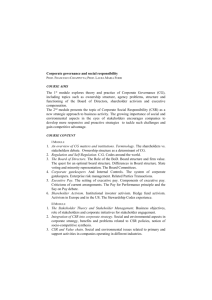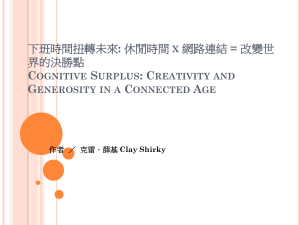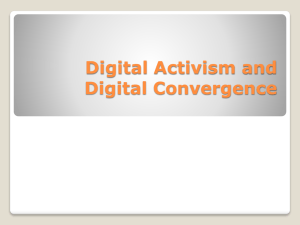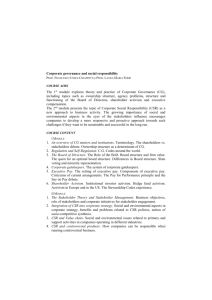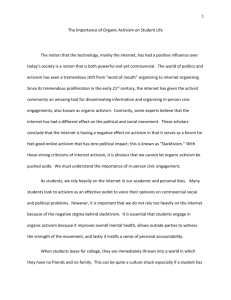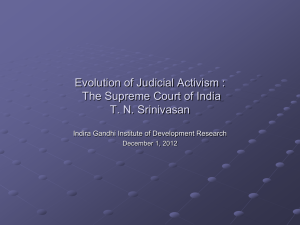Student TiC 3 - WordPress.com
advertisement
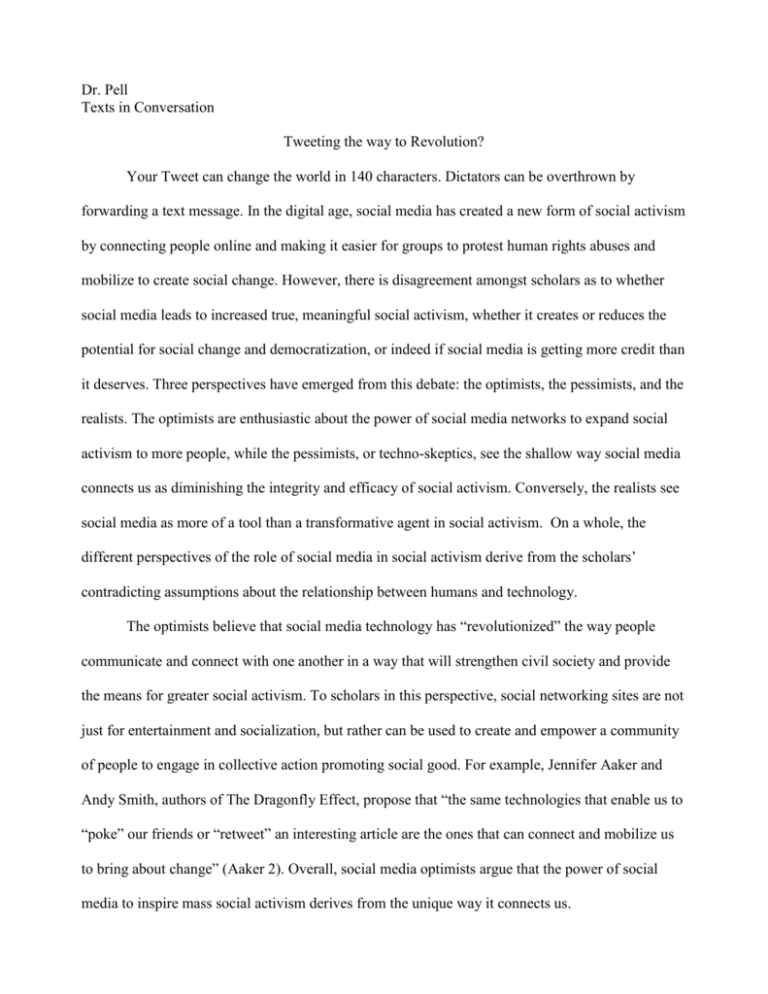
Dr. Pell Texts in Conversation Tweeting the way to Revolution? Your Tweet can change the world in 140 characters. Dictators can be overthrown by forwarding a text message. In the digital age, social media has created a new form of social activism by connecting people online and making it easier for groups to protest human rights abuses and mobilize to create social change. However, there is disagreement amongst scholars as to whether social media leads to increased true, meaningful social activism, whether it creates or reduces the potential for social change and democratization, or indeed if social media is getting more credit than it deserves. Three perspectives have emerged from this debate: the optimists, the pessimists, and the realists. The optimists are enthusiastic about the power of social media networks to expand social activism to more people, while the pessimists, or techno-skeptics, see the shallow way social media connects us as diminishing the integrity and efficacy of social activism. Conversely, the realists see social media as more of a tool than a transformative agent in social activism. On a whole, the different perspectives of the role of social media in social activism derive from the scholars’ contradicting assumptions about the relationship between humans and technology. The optimists believe that social media technology has “revolutionized” the way people communicate and connect with one another in a way that will strengthen civil society and provide the means for greater social activism. To scholars in this perspective, social networking sites are not just for entertainment and socialization, but rather can be used to create and empower a community of people to engage in collective action promoting social good. For example, Jennifer Aaker and Andy Smith, authors of The Dragonfly Effect, propose that “the same technologies that enable us to “poke” our friends or “retweet” an interesting article are the ones that can connect and mobilize us to bring about change” (Aaker 2). Overall, social media optimists argue that the power of social media to inspire mass social activism derives from the unique way it connects us. Specifically, the optimists theorize that social media connects people by providing a shared set of information and creating a sense of group identity across a network of people who may have never met. For instance, Clay Shirky postulates that in a “networked society” common membership to a facebook group or following someone on twitter is enough to satisfy the minimal conditions that can foster a sense of group identity amongst complete strangers; this social phenomenon is known as the Minimal Group Paradigm (Shirky, 44). Neil Postman expands this idea of collective identity amongst social network users to argue that the internet has created a “global village” (Postman, 2). In Postman’s concept of the “global village”, social media inevitably leads to globalization by providing people across the world access to the same information, and thus creating a common globalized culture as well as habitual ways of thinking. Moreover, Lance Strate applies Postman’s ideas about globalization to explain how online social media is moving society toward a new form of “collective consciousness” (Strate, 80). In particular, he illustrates how the new ways people connect and communicate online leads society as a whole to “become less distanced and objective, and more emotionally involved with our world and our fellow human beings” (Strate, 79). These optimistic claims by Postman and Strate stem from the belief that technology has the power to transform society for the better. This basic assumption is best illustrated through Postman’s assertion that “technology is a medium within which a culture grows…it gives form to a culture’s politics, social organization, and habitual ways of thinking”. Indeed, from the perspective of social media optimists, or perhaps more aptly named ‘techno-enthusiasts’, technology is the key agent of change and progress in society. Building off this common assumption, Aaker and Smith imagine that social media can use the collective identities it creates to “inspire all these networked people and empower them to participate in global movements for change” (Aaker, ix). This is made possible by what Aaker and Smith term “the ripple effect” and “emotional contagion”. The ripple effect results when a small action, such as creating a facebook page to bring awareness to a human rights issue, has a significant positive impact on others. This acts as a form of positive “emotional contagion” that inspires others within the networked community to help (Aaker, 10). Indeed, this parallels Shirky’s theory of the “epidemiology” of group action and social activism across social media networks (Shirky, 159). In this way, by spreading emotions and creating connections between people, technoenthusiasts claim that social networks are effective at increasing motivation to do social good. Moreover, Aaker and Smith point out that social media is unique because it provides the tools to promote such social good to the masses for the first time. In fact, they suggest that “you don’t need money or power to cause seismic social change” (Aaker, xi). This idea is personified in what the authors call the ‘Dragonfly Effect’, defined as the “efficacy of people who, through the passionate pursuit of their goals, discover they can make a positive impact disproportionate to their resources” (Aaker, 2). In this optimistic perspective, social media has revolutionized the concept of social activism by making it accessible to all. Anyone, regardless of political clout or net-worth, can feel like a social activist by simply joining a facebook group, signing an online petition, or forwarding a tweet that has something to do with human rights. Shirky takes Aaker and Smith’s idea a step further by arguing that “social tools have changed the balance of power” in society by shifting it from governments and formal organizations to the masses (Shirky, 164). Particularly, he claims that social media has removed barriers that prevented large, loose groups of ordinary people from coordinating mass social action. Shirky uses the military concept of “shared awareness” to describe the type of coordination that empowers social media users. Shared awareness is defined as “the ability of each member of a group to not only understand the situation at hand but also understand that everyone else does, too” (Shirky, 40). By propagating messages through social networks, social media increases shared awareness and allows people to come together in collective social action. In this sense, Shirky implies that the very fact that social networks do not have a hierarchical organization makes them successful tools for encouraging mass social activism. Indeed, he bases this argument on the fact that many of the ‘twitter revolutions’ during the Arab Spring did not have a clear leader, but were simply average citizens united behind the common goal of democracy. In these cases, techno-enthusiasts like Shirky exult how social media has expanded social activism because it no longer needs a powerful leader to be effective. Furthermore, Shirky believes that this aspect of social media can actually bring a “net improvement to democracy” (Shirky, 5). He thinks of social media as tools that can strengthen civil society and inspire political activism in the long term by better informing and coordinating the masses. Here, Shirky’s claims rest on the basic assumption that communicative freedom leads to more political freedom. The view that new communication technologies, like social media, enable progress toward a better, more global and free society is the underlying assumption of the technoenthusiast worldview. Indeed, the optimistic predictions of social media’s role in social activism made by scholars in this perspective stem from their shared assumptions about how technology shapes human society. More specifically, the techno-enthusiasts subscribe to a linear view of history and progress, in which each new technology brings society closer to a more democratic and globalized utopia. These assumptions lead scholars to conclude that by connecting people across society, social media empowers and expands social activism. However, these basic assumptions are what separate the social media optimists from the pessimists, or techno-skeptics. Significantly, in opposition to the optimists, the techno-skeptics believe that progress for progress sake is not necessarily good, and often times technologies actually degrade rather than advance society. Consequently, scholars in this perspective are particularly pessimistic about social media, claiming that it corrupts the integrity of social activism by reducing the risk and effort required to be a social activist. They also see the chaotic, disorganized nature of social media as impeding effective social activism and real change in society, and point to how it can be exploited by authoritarian government to actually harm democracy. First of all, the assumptions of techno-skeptics lead them to a very different view of how social media connects people compared to techno-enthusiasts. For example, techno-skeptics in the media, like Malcolm Gladwell, point out that the way social media connects us is too shallow and superficial to create collective identities or inspire group action that Aaker and Shirky describe (Gladwell,43). This view is based on the sociologist Doug McAdam’s theory that high risk social activism is dependent on “strong ties” within groups. In his study of the Freedom Summer during the Civil Rights movement, McAdam found that the primary determinant of who took part in activism was not the individual’s ideological fervor, but rather the number of “critical friends” the individual had who were also involved in the movement (McAdam, 30). However, online social activism is nothing like this because social media is built on weak ties individuals that might have never met. For this reason, McAdams would argue that such bonds are not strong enough to inspire an individual to take a risk in order to promote social change, or be a true social activist. Consequently, techno-skeptics denounce the techno-enthusiast construct that social media creates a networked society that can unite to engage in activism. Instead, the pessimists hold that online social activism is predominantly driven not by Aaker’s concept of “emotional contagion”, but rather by peer pressure and the desire to impress friends. This trend is explained by Jenny Twenge, who claims that the structure of social networking sites actually “rewards the skills of the narcissist, such as self-promotion, selecting flattering photographs of oneself, and having the most friends” (Twenge, 20). For this reason, the online campaigns individuals join may be more likely to represent what kind of person they want to be seen as rather than their actual commitments to social causes. In this pessimistic view, social media may not be inspiring more social activists but rather making it easier for people to present themselves as social activists to their friends. Malcolm Gladwell combines Twenge and Mcadams’ analyses of the sociology of social networks to refute Aaker and Smith’s theory that social media increases motivation to do social good. Instead, he asserts that social media increases participation “by lessening the level of motivation that participation requires” (Gladwell, 43). In fact, Gladwell argues that social media does not enable greater social activism but rather leads to the phenomena of “slacktivism” (Gladwell, 46). Slacktivism is when individuals feel good about themselves by participating in an effortless mode of activism as opposed to exerting actual effort to create change. For instance, facebook campaigns to protest authoritarianism or promote human rights get thousands of users to join by asking the minimal required of them, such as taking 30 seconds to sign a petition or donate a few dollars. This gives users the illusion that they are making a difference, but does little to effect real change. Gladwell claims that these ‘slacktivists’ are not true activists because the very things that encourage them to act, such as the little effort it takes to join a campaign and low financial or physical risk to participate, diminishes the integrity of their social activism. Moreover, Diana Allan proposes that the structure of social networks actually undermines the ability of social activists to create meaningful change. She points out that “it is very easy to overestimate the “leveling” effect of social media” and assume, as Shirky does, that social media shifts the balance of power to the masses (Allan, 69). Instead, Allan depicts how social media can be used by authoritarian governments to broadcast propaganda. She explains that social media does not change the balance of power because governments still have larger clout and audience on sites like twitter and youtube compared to a disperse group of individual activists, especially when the activists have no central leader. Here, Allan disproves Shirky and the techno-enthusiasts’ claim that the lack of hierarchy in social networks enables social activism. For true, effective social activism, pessimists believe a hierarchy of leadership is necessary to coordinate action and draw an audience. Eric Trager strengthens this argument by illustrating the power vacuums that leaderless social media revolutions create, which actually undermine the goal of democracy. He points to the example of Egypt, where social media allowed young, liberal protesters to oust a dictator but did not provide a clear leader to the movement. Now, Trager describes how “the Muslim Brotherhood…is seizing the political momentum” because it is more cohesive and organized than the original protestors, even though it has less-than-democratic plans for Egypt (Trager, 114). In this, Trager contradicts Shirky’s argument that social media can bring a ‘net improvement to democracy’ through the way it mobilizes the masses. Overall, Trager and fellow techno-skeptics see social media as the antitheses to effective social activism because it does not provide the leadership, hierarchy, or social bonds that successful social movements require. However, despite their opposing views of how social media enables or restricts social activism, both the optimists and pessimists operate under the assumption that technology shapes humans and society rather than vice versa. They see social media as having a political agenda, in that it has either a mobilizing or corrupting effect on social activism. However, proponents of a third perspective, the ‘realists’, disagree with this fundamental assumption. In particular, Evgeny Morozov charges the above scholars with adhering to “internet-centrism”, or the flawed perception of social media changing a society rather than being adapted to a society (Morozov, 9). Morozov adds that “what is most dangerous about succumbing to technological determinism is that it hinders our awareness of the social and the political, presenting it as the technological instead” (Morozov, 293). Thus, realists like Morozov understand that people are not passive victims of technology, but are rather active appropriators (Morozov, 292). In this perspective, there is no such thing as a ‘twitter revolution’ because social media does not inherently change the nature of social activism. In fact, Morozov shows that the West historically tends to over-exaggerate its role in promoting revolutions and that this worldview leads them to give social media more credit than it deserves. He traces this trend back to the Cold War, where the West credited itself for bringing down communist nations through supporting free speech and the spread of democratic ideas (Morozov, 179). Applied to the modern day, Morozov describes how this view led commentators during the Arab Spring to conveniently credit American social networking technology with bringing down authoritarian regimes. Fellow realist, Jonathon M. Acuff employs this idea to explain that “although it is intrinsically appealing to believe that the US is such a beacon of hope and democracy that we inspire freedom-loving people everywhere to throw off their chains…we should be more skeptical concerning the claims of those who interpret every mass protest as ‘freedom on the march’” (Acuff, 225). Therefore, realists illustrate that the western idea that social media is responsible for mass protest everywhere is a conceited oversimplification. Moreover, Morozov dismisses the techno-enthusiasts perspective as part of a pattern throughout recent history to predict that a newly introduced technology has the ability to democratize and globalize the world. He depicts how “From the railways…to television, that greatest liberator of the masses, there has hardly appeared a technology that wasn’t praised for its ability to raise the level of public debate, introduce more transparency into politics, reduce nationalism, and transport us to the mythical global village” yet none were able to follow through on initial promises (Morozov, 275). Anais Saint-Jude builds off this argument to point out that social media is neither new nor revolutionary, but rather represents another period of “information overload” that previously occurred in Europe during the 17th and 18th centuries (Saint-Jude in Haven, 2). Here, the realist’s analysis of social media stems from different views of history and progress from the optimists and pessimists. Namely, realists believe that history does not progress linearly but rather repeats itself; human society does not improve or degrade over time with the advent of new technologies, but rather people view and use technologies the same way they always have. Therefore, the divergent claims made by optimists, pessimists and realists about the role of social media in social activism stems from their different views of the relationship between humans and technology. However, they fail to examine how the different politics and culture of a society changes the role of such technologies in social activism. The realists point out that technology adapts to a society rather than changing a society, but they fail to explain how different societies uniquely view and alter technology to suit their needs. For instance, the media has reduced the Arab Spring revolutions as well as Occupy Wall Street into the simple formula that social media has enabled social activism on a large scale. But in reality, these societies and the stakes involved in the protests are so disparate that to say they are the same type of protest would be a gross oversimplification. In particular, social activism involves greater personal risk in nations under authoritarian regimes in places like the Middle East and China than in more liberal states like the U.S. Consequently, social media technology is adapted to suit the unique politics and culture of a nation and in turn produces inherently different forms of social activism. Works Cited: Aaker, Jennifer Lynn, Andy Smith, and Carlye Adler. The Dragonfly Effect : Quick, Effective, and Powerful Ways to Use Social Media to Drive Social Change. San Francisco: JosseyBass, 2010. Allan, Diana, and Curtis Brown. “The Mavi Marmara At the Frontlines of Web 2.0.” Journal of Palestine Studies 40.1 (2010): 63-77. Academic Search Premier. Web. 2 Nov. 2011. Gladwell, Malcom. “SMALL CHANGE.” New Yorker 86.30 (2010): 42-49. Academic Search Premier. EBSCO. Web. 25 Oct. 2011. Haven, Cynthia. "New Social Media? Same Old, Same Old, Say Stanford Experts." Stanford News. Stanford University. Web. 13 Nov. 2011. <http://news.stanford.edu/news/2011/november/old-social-media-110211.html>. McAdam, Doug. Freedom Summer. New York: Oxford University Press, 1988. Morozov, Evgeny. The Net Delusion : the Dark Side of Internet Freedom. New York: Public Affairs, 2011. Postman, Neil. Amusing Ourselves to Death : Public Discourse In the Age of Show Business. 20th anniversary ed. New York, N.Y., U.S.A.: Penguin Books, 2006. Shirky, Clay. Here Comes Everybody : the Power of Organizing Without Organizations. New York: Penguin Press, 2008. Strate, Lance. “The Future of Consciousness.” ETC: A Review of General Semantics 66.1 (2009): 63-83. Academic Search Premier. Web. Trager, Eric. “The Unbreakable Muslim Brotherhood.” Foreign Affairs 90.5 (2011):114-126. Academic Search Premier. Web. Twenge, Jenny and Bushman, Brad J. “Further Evidence of an Increase in Narcissism Among College Students.” Journal of Personaly 76.4 (2008): 919-928. Academic Search Premier. EBSCO.

